If you’ve always wanted to learn how to cross stitch, but it seemed too complicated, you’re in the right place. Get started with cross stitch by learning the two primary methods of cross stitch, and 3 ways of implementing them. Thread your needle, secure your thread, and let’s get started!
Don’t worry, this is easy.
For a quick demonstration, check out this video.
What is Cross Stitch?
Cross stitch is an ancient form of embroidery that folks have been using to embellish clothing, create handmade art and gifts, and to pass the time. It consists of a series of stitches that produce X’s in neat rows and columns on even weave cloth such as aida or linen. “Even Weave” just means that all of the threads in the cloth are woven to be spaced evenly. Imagine that each hole in the fabric represents a corner for a square block in the fabric. This creates a grid of fabric squares on the cloth.
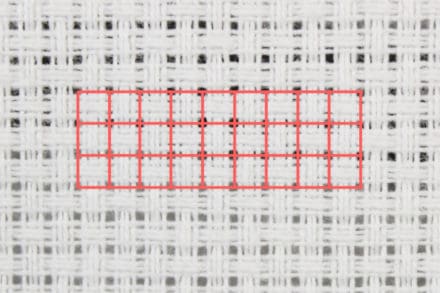
The X’s work like pixels and form patterns and pictures into anything you want!
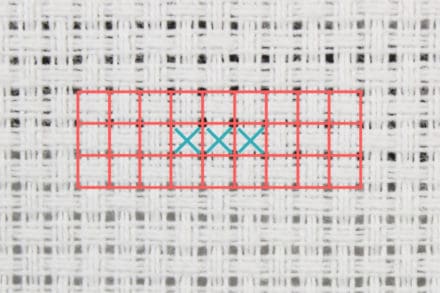
Each X is formed first by creating a half stitch – a diagonal slash. From the back, push up a threaded needle through one of the corners in the fabric square (#1 in the picture below). Then, from the front, push the needle through the opposite corner on the fabric square (#2 in the picture below).
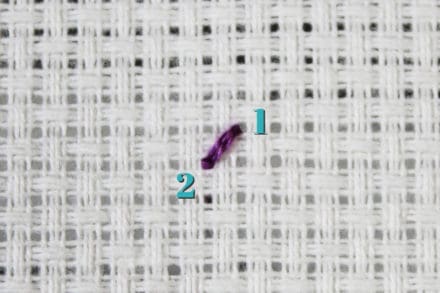
The cross is formed by creating another diagonal slash over the first half stitch, but in the opposite direction. (#3 and #4 below)
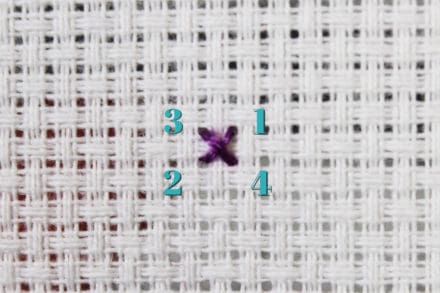
Tension Can Affect Your Stitches
Tension refers to how tight you pull the thread to complete each stitch. Pull too tight, and the fabric or cloth is distorted and bunched up. This can make big, ugly holes.
Kept too loose, and you risk putting the needle through previous stitches and just creating a mess. If you try to end a thread that was stitched too loosely, the whole thing could start to unravel.
I suggest you practice a bit if you’ve never done embroidery before. Just take 10 minutes to make several crosses. Try experimenting by stitching a few too tight or a few too loose on purpose to see what happens. You should also practice whenever you work on a new type of fabric for the first time.
What are the types of cross stitch?
There are many terms for the various methods and types of cross stitch embroidery and patterns you may have heard about, and several overlap. I’m going to show you how to do each of the most popular categories of cross stitch based on the type of pattern, the order of the stitches and a few of the different stitching techniques.
Pattern Types
There are two different types of cross stitch pattern charts.
1. Stamped Cross Stitch Patterns
Have you ever seen those cute little embroidery kits in the needlework isle of your favorite craft store with blue ink preprinted on the fabric? This is Stamped Cross Stitch, named because the pattern is already stamped onto the fabric. This is the easiest type of pattern to follow because you only have to stitch over the lines that are already there. No counting. Follow the pattern and you can’t mess it up. Bonus!
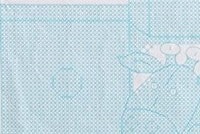
Stamped cross stitch is a great way to learn cross stitch. It’s easy to follow and the patterns are quite small, with few stitches, which makes them fast and easy to finish. This is perfect for some adults with short attention spans. (You know who you are.)
2. Counted Cross Stitch Patterns
In Counted Cross Stitch, each square in the pattern chart is counted, and then stitched onto the cloth. The patterns usually mark the grid on the chart with thicker lines every 10 stitches, like in the sample below, to make it easier to follow. Be more careful with these patterns because it’s really easy to make mistakes. One stitch off and the whole pattern can be misaligned.
My mom taught me to Count twice – stitch once! 😉 I sometimes still make these mistakes. Meh.
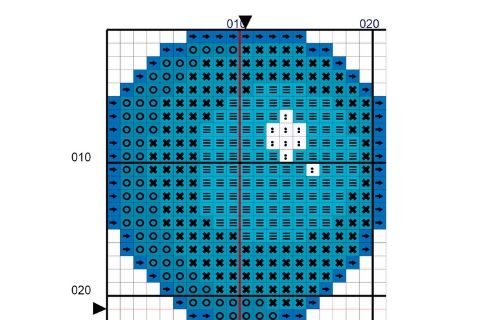
Two Cross Stitching Methods
Here’s where we get to the meat and potatoes!
There are a couple of methods of laying down the slash and the cross that makes up cross stitch.
1. The Danish Method of Cross Stitch
Creating cross stitch using the Danish method means that first, stitch all the slashes in a row.
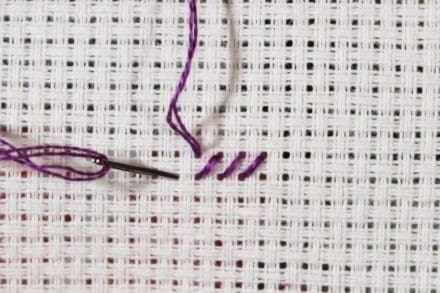
Then, stitch all the crosses in that row. You can stitch in columns, too, depending on your preference and style.
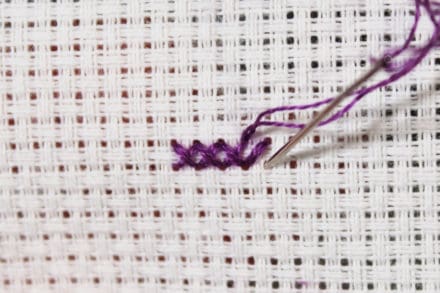
And the back comes out nice and neat!
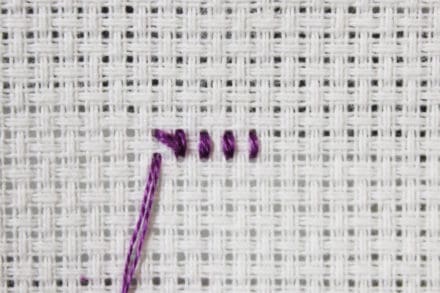
The back of these Danish Method Stitches is showing that they were started with Loop Start.
2. The English Method of Cross Stitch
Cross stitching using the English method just means that each cross is completed before moving on to the next cross or fabric square.
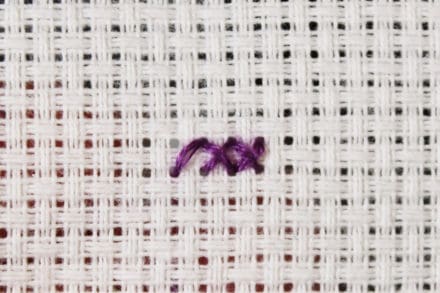
Although it is more simple, the English method doesn’t come out as neat on the back.
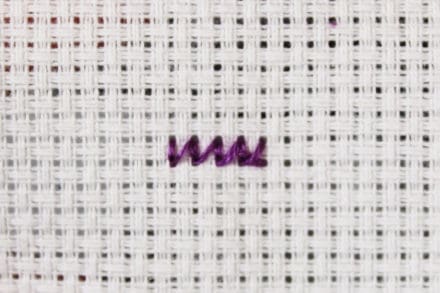
Should I Use English or Danish Method?
I choose to primarily use the Danish method because the back comes out so much neater. Usually, the back doesn’t even matter – I’m just obsessed with a tidy backside! The back only matters when it will be seen, such as Christmas tree ornaments with no backing, or bookmarks, or if you happen to be creating something for a competition. I also recommend the Danish method for big blocks of single color cross stitch. Going row by row, you’ll probably find any mistakes sooner and have to undo fewer stitches to fix any errors.

The English method is ideal for sparse patterns with stitches spaced out like confetti. It also works better on some forms of linen even weave when very small fabric squares. When stitching “over 1”, using the Danish Method might cause the stitches to unravel as you are stitching them.
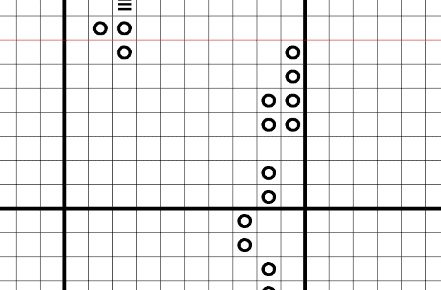
Cross Stitching Techniques
The Sewing Technique for Cross Stitch
Cross stitching using the sewing technique is a variation on the Danish method, except that you don’t hold the fabric flat and tight. Start by securing the thread with the first stitch. You don’t have to actually fold the fabric all the way, as I do in these pictures. I exaggerated so you could better see how the stitches are done. But it is easier to do if the fabric isn’t very taut.
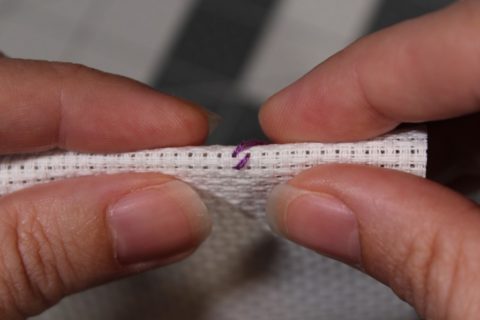
Each stitch is formed by pushing the needle through two holes at a time.
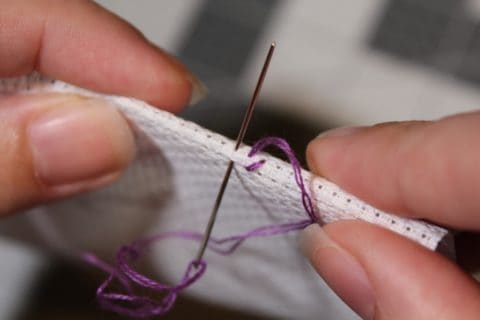
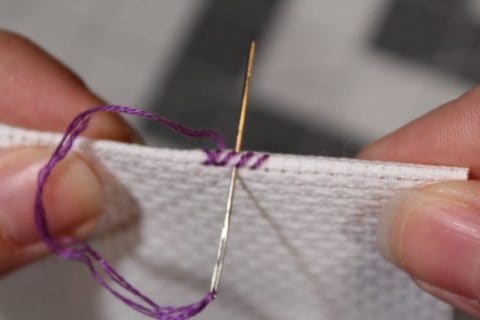
Continue until you have completed all the slashes for that row. Finish the row and complete all the crosses.
I recommend you try the sewing technique after you have a bit of experience with cross stitch. It can be especially difficult getting the tension of your stitches right. The sewing technique can be used to save time, but you want to avoid rushing so much that you make a mistake in the pattern.
You can’t use an embroidery hoop with this technique, but I know stitchers who swear they save a lot of time making cross stitch this way.
Never Miss a Tutorial
Become a Notorious VIP and get new tutorials delivered straight to your inbox. Plus get exclusive access to free patterns.
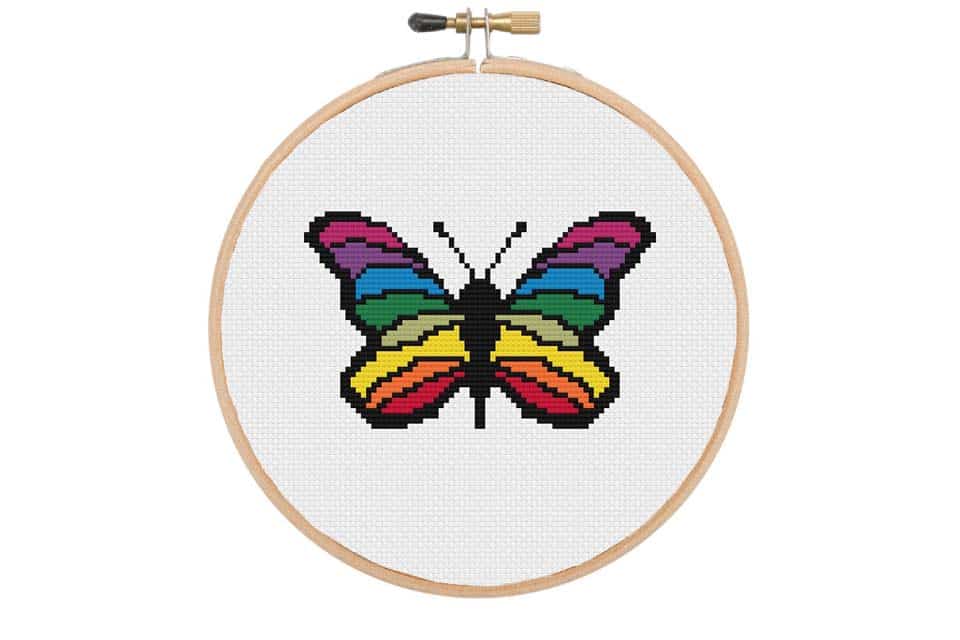
Cross Stitching Two-Handed
You can stitch two-handed using either the English method or the Danish method. It doesn’t matter which way you choose to stitch, or if you want to use both for different parts of your pattern. Stitching two-handed means that you use a stand-alone frame. Frames come in many variations of floor stands, lap stands and table stands. Neither of your hands is holding the project, and you stitch with both hands, passing the needle back and forth.
For instance, let’s say you have a project in a stand on the floor.
This is the one I have.
Both hands are free for cross stitching since the stand holds the cloth tight and steady. First, push the needle from the back using your dominant hand, usually the right hand. Then, pick up the needle with the non-dominant hand, usually the left hand, in the front, and push it through to the back again.
Two Handed – Advantages and Disadvantages
One advantage of stitching two-handed is that it can shave some time off of each stitch. When you’re working on a very large project, that time can add up. Another advantage is better posture. Adjust the frame to an ergonomic height and you will sit up straighter. Plus, a lot of YouTubers use frames and stands so that their project is easy to see by the camera.
The primary disadvantage to the two-handed technique is that it’s not very portable. A stand and frame are required, and that won’t work if you’re, say, waiting at the airport or bringing your project along for a stitching circle.
Another disadvantage to consider with standing frames is that they are not always easy to flip over and see the back. Advanced stitchers learn to bury their threads from the front so they never have to flip the cloth over.
Cross Country Cross Stitch
Stitching cross country means that every stitch in the whole pattern for one color is completed before moving on to the next one. I love stitching this way! It’s deeply satisfying to have “little finishes” as each color is done.
You should double-count all of your stitches when moving on to a new section. I find it easier to follow the pattern one color at a time.
This is an example of a cross country cross stitch birth announcement I’m working on now, at the time of this writing, for my niece. It’s an excerpt of “Sea Babies”, Book 431 of the Stoney Creek Collection.
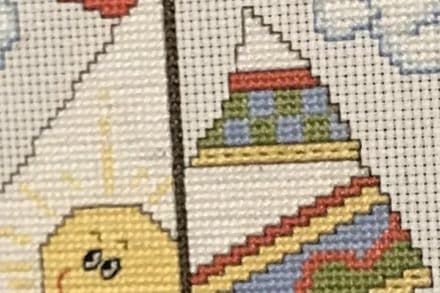
This is the back. It looks almost as good as the front! No threads have been dragged across the pattern and there are no dangling threads.
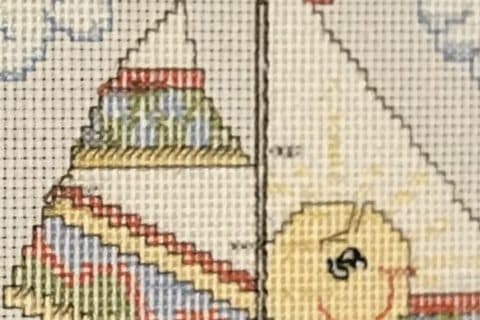
The primary disadvantage to the Cross Country technique is that it is easy to make mistakes. If the pattern has a patch of the color you’re working on that is far away, the farther you have to count to start the next section, the more likely you are to make a mistake.
Using the Parking Technique
The parking technique is best used for full coverage cross stitch patterns. “Full coverage” means that every single little square on the fabric – usually aida cloth – has a cross stitch on it. (I don’t usually do these types of patterns, which is why I haven’t tried this yet.)
This is a variation on the English method. Stitch the cross stitch pattern in sections at a time, usually 10 x 10 squares.
I don’t want to go into detail regarding the Parking Method because I don’t recommend it when you’re just starting out.
Why I Don’t Recommend It
In the interests of full disclosure, I’ll be perfectly honest with you – I have never tried the parking technique. It looks like a hot mess to me and, well, I’m obsessed with neat work, even on the back. I WILL try it though, and when I try it out, I’ll be sure to post about it.
Stitchers, try it at your own risk. 😉
The parking technique just doesn’t appeal to me, and I can’t recommend it for beginner stitchers. It looks messy and uses a lot more embroidery floss. A LOT more. However, some people love it, especially for full coverage projects. By doing only a section of the pattern at the time, you are much less likely to make mistakes. When every square in a large project is covered in cross stitches, I can understand how avoiding mistakes can be important.
When you’re ready to learn more, The Peacock & Fig has a pretty good explanation for the Parking Method.
It’s All Up To You
I prefer a variation on the Cross Country Technique. For instance, on the “Sea Babies” pattern I’m currently working on, I don’t necessary stitch all of one color on the whole pattern at a time. For the wind sail sample you saw in the picture above, I first stitched all the yellow in the sail. Then, I stitched all the white, followed by the black, and finished the area with the back stitches.
I completed the section of the wind sail before moving on to the bottom of the boat. Then I stitched the boat, one color at a time. This is not the pure cross country technique, but I find that it still offers some of the advantages, while limiting the potential for mistakes.
Remember, it’s always your choice. There are best practices for competitions and cross stitch snobs like me, but this is your art! There’s no wrong way. You can do whatever you want!
Have FUN and Stitch On!

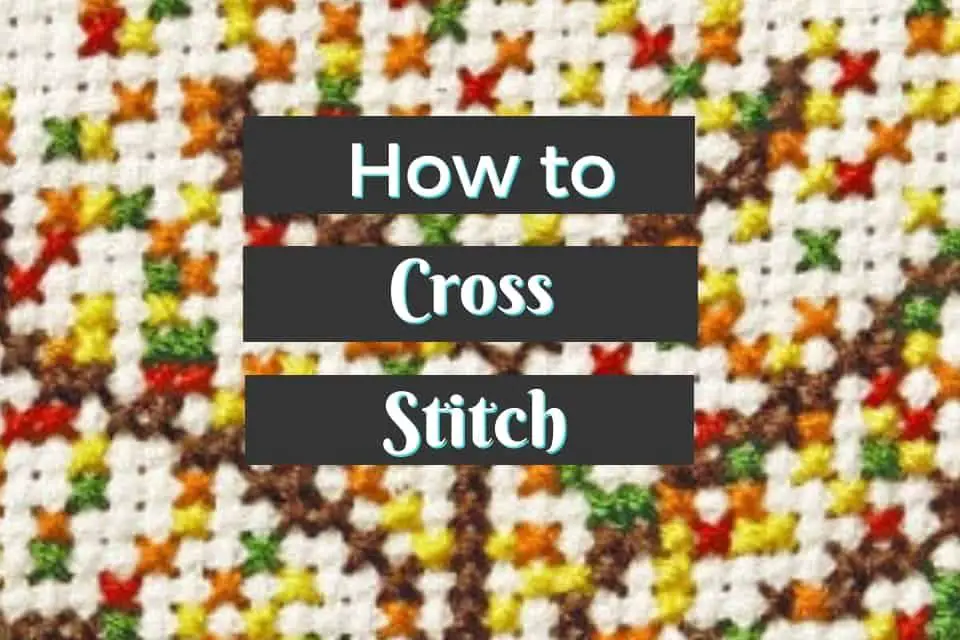

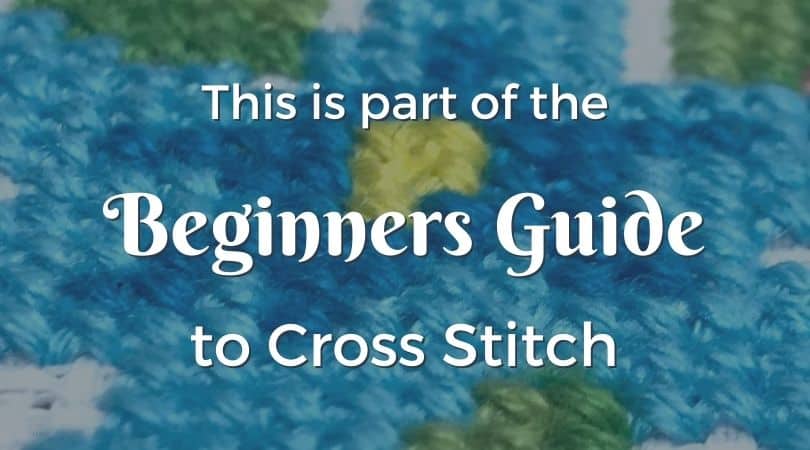
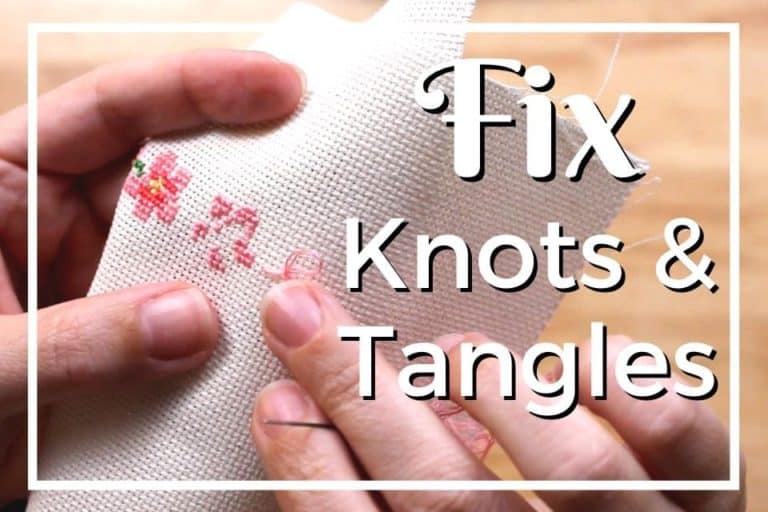
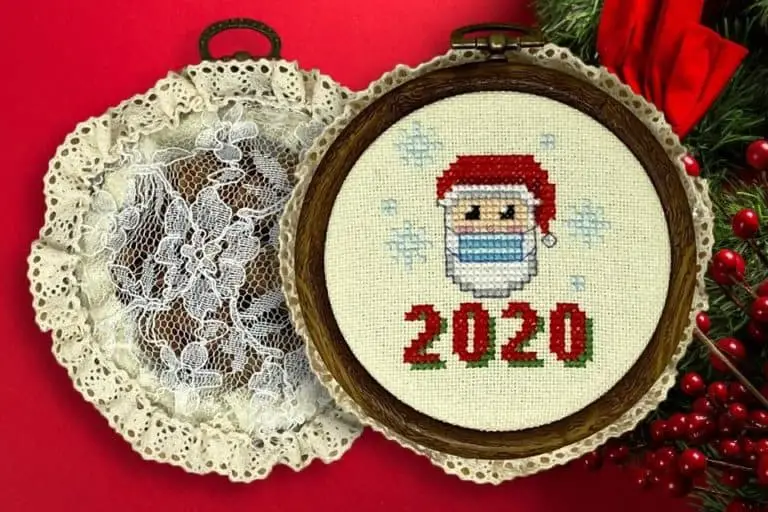
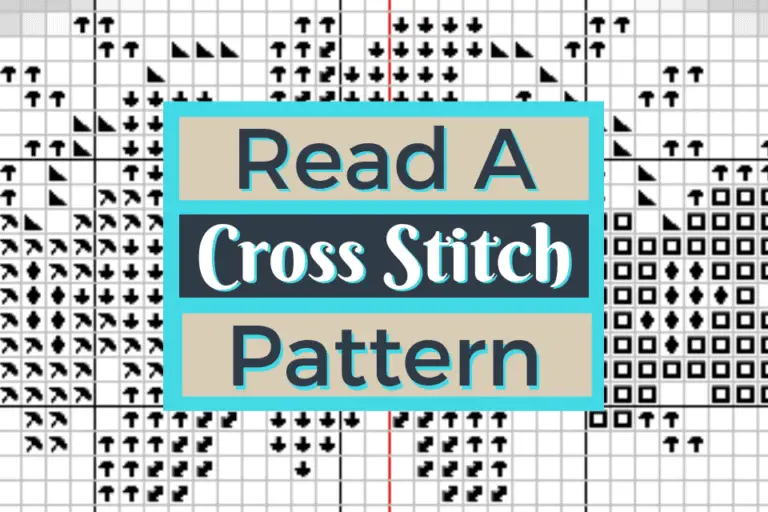
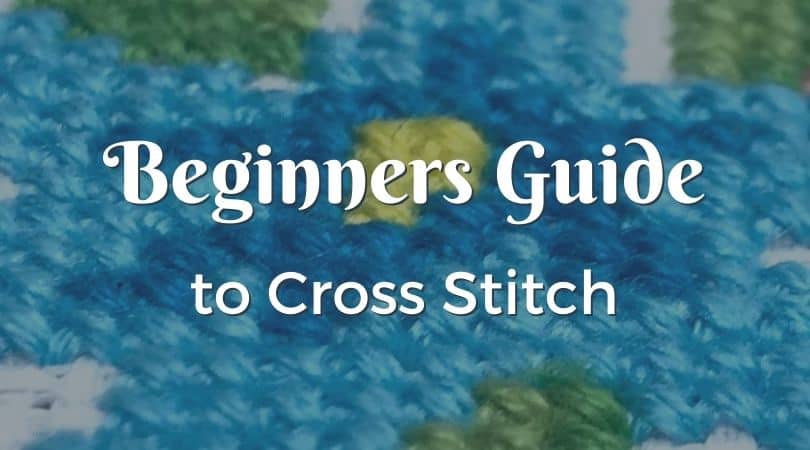
8 Responses
Great information!! I really enjoy reading this blog information. Thanks for sharing this information.
You’re very welcome! SO glad you found it enjoyable.
Hi I’m currently cross stitching on stamped cloth which I have never done before. The x’s do not meet or touch, should I cross stitch each x as individual or should I cross stitch in the same hole so they appear joined as you would in counted cross stitch?
Welcome Lesley 🙂
The stamped projects I’ve done had really big X’s. They did not touch and were more spaced out. But none of those projects were on aida cloth or linen – they were baby bibs and other fluffly things (with no weave and no holes) and I needed a sharp, pointy needle to get the stitches through. If that’s what you’re stitching on, it will be easier to stitch just how it’s stamped, with the spaced out Xs. Plus, the look adds a bit of charm.
If you’re stitching on a type of evenweave cloth like aida or linen, I think you’ll find going through the same holes creates a more smooth look and your stitches are evenly lined up. This will bring the eye more to the picture with less distraction of the texture of differently sized stitches.
Even so, uneven stitches can have an artsy appeal, too!
I hope that answers your question. Most important, enjoy!
Hi Sarah. I’m kinda new to cross stitching. I like things neat and orderly too. When you are working a pattern and you start in the middle, it makes me nervous, do you have any advise on that? I would prefer to start in the very first cell, working left to right, top to bottom, lol!!! I know that all stitches should be the same direction, but my first piece, I didn’t cross over more than 3 blocks if the color ended but to make a stitch closer sometimes I would go up in hole 2, down in hole 1, up in hole 4 and down in hole 3. All the stitches are slanted and crossed the same. Sometimes I would go right to left, and left to right. Up and down and down and up. Should I stay more consistent and only go up in hole 1, down in hole 2, up in hole 3 and down in hole 4 always working left to right and top to bottom? My back looks pretty neat, but not as neat as yours. I don’t mind if something takes a little longer, b/c I want to do it correctly, neatly and as orderly as I can. Thank you for posting all the information you have posted.
Hi Amy, so glad you found this info helpful! I definitely prefer to start my cross stitch patterns near the middle. This centers the project on the fabric, which really helps when you need to frame it when you’re done stitching. Lot’s of folks start how you start: in one of the corners. And this works very well if you have a very large, full-coverage project.
I LOVE making the backs super neat, but most stitchers I know don’t fuss too much about it. And contemporary wisdom tells us the back doesn’t matter, because no one ever sees it. If you’re like me and you want the back to be neat, try to be more consistent with the order you stitch, pretty much how you’ve already suggested 🙂 and this will make the back and front more neat. Sounds like you’ve got the hang of this.
The great things about fiber art is that you can do it however makes your heart sing!
Thanks for making it so I didn’t have to lol
Thanks for sharing my link to my parking method tutorial Sarah! I agree, parking makes everything look like a hot mess, personally it makes me batty. 🙂